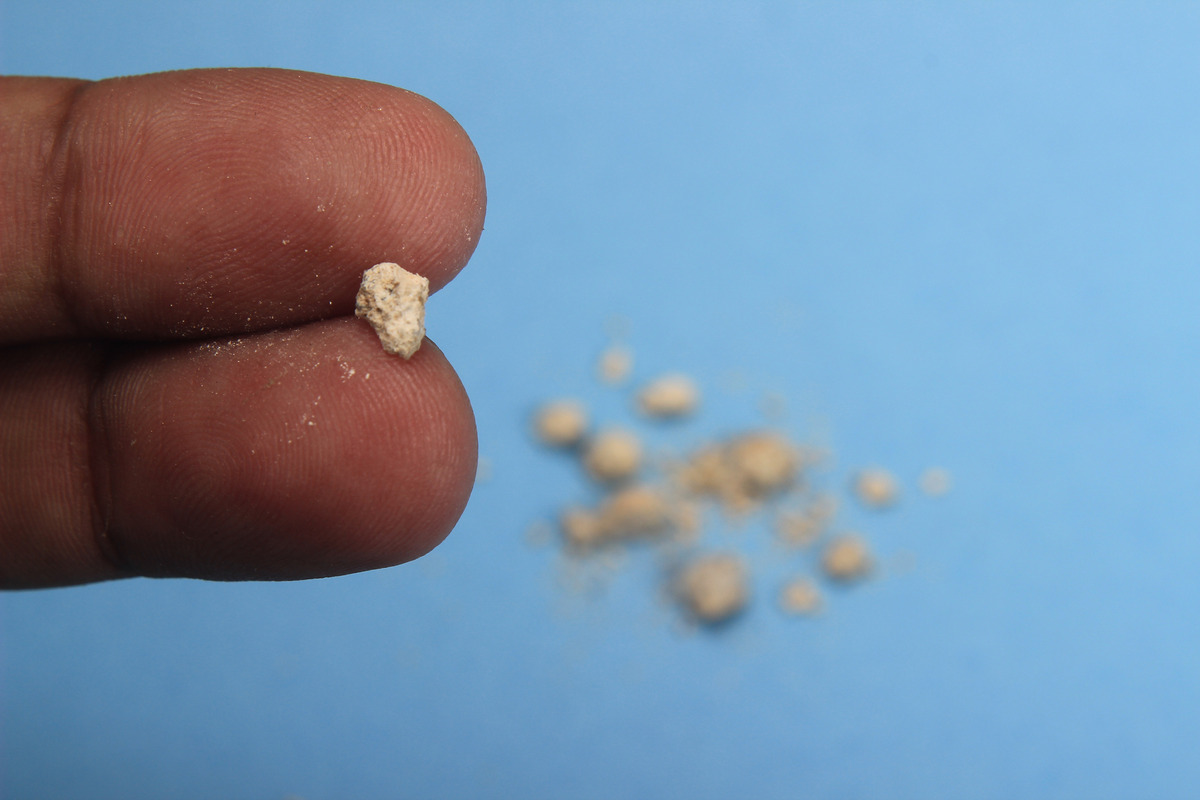Home>Health and Wellness>The Astonishing Speed At Which Staghorn Kidney Stones Grow!


Health and Wellness
The Astonishing Speed At Which Staghorn Kidney Stones Grow!
Published: February 2, 2024
Learn about the rapid growth of staghorn kidney stones and their impact on health and wellness. Discover effective prevention and treatment options.
(Many of the links in this article redirect to a specific reviewed product. Your purchase of these products through affiliate links helps to generate commission for Noodls.com, at no extra cost. Learn more)
Table of Contents
Introduction
Staghorn kidney stones, a formidable and potentially life-altering condition, have garnered attention for their astonishing growth rate. These complex stones, often characterized by their large size and intricate branching structure, can pose significant challenges to patients and healthcare providers alike. The rapid progression of staghorn kidney stones is a cause for concern, prompting a deeper exploration into the factors influencing their growth and the potential treatment options available.
In this article, we will delve into the captivating realm of staghorn kidney stones, shedding light on their composition, growth patterns, and the impact they can have on individuals' health. By examining real-life case studies and analyzing the contributing factors, we aim to unravel the enigma surrounding the accelerated development of these formidable stones. Furthermore, we will explore the treatment modalities designed to address this condition, offering hope and relief to those grappling with its daunting implications.
Join us on this enlightening journey as we uncover the astonishing speed at which staghorn kidney stones grow, unraveling the mysteries that shroud this intricate aspect of urological health.
What are Staghorn Kidney Stones?
Staghorn kidney stones, also known as struvite stones, are formidable mineral deposits that form in the kidneys and can grow at an astonishing pace. Unlike smaller kidney stones that may pass on their own, staghorn stones are characterized by their large size and intricate, branching structure, making them particularly challenging to manage. These stones are primarily composed of magnesium, ammonium, and phosphate, and are often associated with urinary tract infections caused by specific types of bacteria.
The unique feature of staghorn kidney stones lies in their ability to occupy a significant portion of the kidney's collecting system, branching out like the antlers of a stag, hence the name "staghorn." Their extensive growth can lead to obstruction of the urinary tract, causing severe pain, urinary tract infections, and potential kidney damage if left untreated.
Staghorn kidney stones are often linked to underlying urinary tract infections, particularly those caused by urease-producing bacteria such as Proteus and Klebsiella species. These bacteria produce urease, an enzyme that hydrolyzes urea in the urine, leading to an alkaline environment that promotes the formation of struvite crystals. Over time, these crystals can aggregate and form staghorn stones within the kidney.
Due to their size and complex structure, staghorn kidney stones pose a considerable risk to the affected individuals. The rapid growth of these stones can result in excruciating pain, urinary obstruction, and recurrent infections, significantly impacting the overall quality of life. Therefore, understanding the nature of staghorn kidney stones and their propensity for accelerated growth is crucial in developing effective strategies for their management and treatment.
In the following sections, we will explore the factors influencing the growth of staghorn kidney stones and examine real-life case studies to gain deeper insights into the rapid progression of this challenging urological condition.
Factors Affecting the Growth of Staghorn Kidney Stones
The growth of staghorn kidney stones is influenced by a myriad of factors, each playing a pivotal role in the rapid progression of these formidable mineral deposits. Understanding these factors is crucial in devising effective strategies for the management and treatment of staghorn stones.
-
Urinary pH and Composition: The pH level of the urine significantly impacts the formation and growth of staghorn kidney stones. An alkaline pH provides an ideal environment for the precipitation of struvite crystals, which are the primary constituents of staghorn stones. Additionally, the composition of urine, including the concentration of minerals such as magnesium, ammonium, and phosphate, directly influences the growth rate of these stones.
-
Urease-Producing Bacteria: Urinary tract infections caused by urease-producing bacteria, particularly Proteus and Klebsiella species, play a pivotal role in the rapid growth of staghorn kidney stones. These bacteria hydrolyze urea in the urine, leading to the production of ammonia and the creation of an alkaline environment conducive to the formation and aggregation of struvite crystals.
-
Obstruction and Stagnation: The presence of an obstruction in the urinary tract can contribute to the rapid growth of staghorn kidney stones. When urine flow is impeded, stagnant urine provides an ideal medium for the accumulation and aggregation of mineral deposits, facilitating the expansion of staghorn stones within the kidney's collecting system.
-
Underlying Health Conditions: Certain underlying health conditions, such as recurrent urinary tract infections, anatomical abnormalities of the urinary tract, and metabolic disorders, can predispose individuals to the accelerated growth of staghorn kidney stones. These conditions create an environment conducive to the formation and expansion of these complex mineral deposits.
-
Dietary Factors: Dietary choices and habits can impact the growth of staghorn kidney stones. Consumption of foods high in certain minerals, such as magnesium and phosphate, can contribute to the formation of struvite crystals and the subsequent growth of staghorn stones.
By comprehensively understanding these factors, healthcare providers can tailor treatment approaches to address the specific underlying causes and mitigate the rapid growth of staghorn kidney stones. In the subsequent section, we will delve into real-life case studies, providing insights into the astonishing speed at which these complex stones can progress.
Case Studies: The Rapid Growth of Staghorn Kidney Stones
-
Case Study 1:
Patient Profile: A 45-year-old male presented with recurrent urinary tract infections and severe flank pain. Imaging studies revealed the presence of staghorn kidney stones occupying a significant portion of the left kidney's collecting system. Further assessment indicated the presence of a urease-producing bacterial infection, creating an alkaline urinary environment conducive to the rapid growth of the stones.Clinical Progression: Over the course of six months, subsequent imaging studies demonstrated a substantial increase in the size of the staghorn stones, causing progressive obstruction and deterioration of renal function. Despite antibiotic therapy to manage the underlying infection, the stones continued to proliferate at an alarming rate, posing a significant challenge to the patient's overall health and well-being.
-
Case Study 2:
Patient Profile: A 55-year-old female with a history of recurrent urinary tract infections presented with debilitating abdominal pain and hematuria. Imaging studies revealed the presence of bilateral staghorn kidney stones, with the right kidney exhibiting a particularly rapid growth pattern. Analysis of the stones confirmed the predominance of struvite crystals, consistent with the influence of urease-producing bacteria.Clinical Progression: Within a span of three months, follow-up imaging indicated a remarkable increase in the size and complexity of the staghorn stones, resulting in severe hydronephrosis and compromised kidney function. Despite aggressive antimicrobial therapy and measures to promote urinary acidification, the rapid progression of the stones necessitated urgent intervention to alleviate the impending risk of irreversible renal damage.
These case studies vividly illustrate the alarming pace at which staghorn kidney stones can grow, presenting formidable challenges to patients and healthcare providers. The intricate interplay of urinary pH, bacterial infection, and underlying health conditions contributes to the accelerated progression of these complex stones, underscoring the critical need for timely and targeted interventions to mitigate their detrimental effects.
In the subsequent section, we will explore the diverse treatment options available for addressing staghorn kidney stones and mitigating their rapid growth, offering hope and relief to individuals grappling with this challenging urological condition.
Treatment Options for Staghorn Kidney Stones
Addressing staghorn kidney stones necessitates a comprehensive approach aimed at mitigating their rapid growth and minimizing the associated complications. The treatment strategies for these formidable stones are tailored to the individual's unique medical history, stone composition, and the extent of renal involvement.
Antibiotic Therapy
In cases where staghorn kidney stones are associated with urease-producing bacterial infections, targeted antibiotic therapy is essential to eradicate the underlying infection. By eliminating the causative bacteria, the alkaline urinary environment conducive to the formation and growth of staghorn stones can be disrupted, thereby impeding their progression.
Percutaneous Nephrolithotomy (PCNL)
PCNL is a minimally invasive surgical procedure designed to remove large kidney stones, including staghorn calculi, from the renal collecting system. This approach involves accessing the kidney through a small incision in the back and utilizing specialized instruments to fragment and extract the stones. PCNL offers a highly effective means of addressing staghorn stones, particularly in cases where their size and complexity pose a significant risk to kidney function.
Endoscopic Stone Removal
Endoscopic techniques, such as ureteroscopy and percutaneous nephroscopy, are employed to directly visualize and remove staghorn kidney stones from the urinary tract. These minimally invasive procedures utilize advanced endoscopic instruments to fragment the stones and facilitate their extraction, often obviating the need for more extensive surgical interventions.
Stone Fragmentation with Shock Wave Lithotripsy
Shock wave lithotripsy (SWL) utilizes focused shock waves to fragment kidney stones, including staghorn calculi, into smaller, passable fragments. This non-invasive approach is particularly suitable for patients with smaller staghorn stones or those who may not be suitable candidates for surgical interventions. However, the effectiveness of SWL in managing staghorn stones is influenced by factors such as stone composition and the extent of stone branching.
Urinary Acidification Therapy
Urinary acidification can be employed to create an environment unfavorable for the growth of staghorn stones, particularly those composed of struvite crystals. This therapeutic approach involves the administration of medications to acidify the urine, thereby inhibiting the formation and progression of staghorn stones. However, the application of urinary acidification therapy must be carefully tailored to the individual's renal function and underlying medical conditions.
Long-Term Management and Prevention
Following the successful treatment of staghorn kidney stones, long-term management and prevention strategies are crucial to minimize the risk of recurrence. This may involve dietary modifications, hydration protocols, and the use of medications to prevent the formation of new stones. Additionally, regular monitoring and follow-up care are essential to assess the effectiveness of preventive measures and address any potential stone recurrence.
By employing a multifaceted approach encompassing medical, surgical, and preventive strategies, healthcare providers can effectively manage staghorn kidney stones and mitigate their rapid growth, offering renewed hope and improved quality of life to individuals grappling with this challenging urological condition.
Conclusion
In conclusion, the astonishing speed at which staghorn kidney stones grow presents a formidable challenge to individuals grappling with this complex urological condition. The intricate interplay of factors, including urinary pH, bacterial infections, obstruction, and dietary influences, contributes to the rapid progression of these formidable stones, underscoring the critical need for targeted interventions to mitigate their detrimental effects.
The case studies presented vividly illustrate the alarming pace at which staghorn kidney stones can expand, posing significant risks to renal function and overall well-being. The relentless growth of these stones necessitates a comprehensive approach to treatment, encompassing antibiotic therapy, minimally invasive surgical interventions, and long-term preventive measures. By addressing the underlying factors driving the rapid growth of staghorn stones, healthcare providers can offer renewed hope and relief to affected individuals.
The diverse treatment options available, including percutaneous nephrolithotomy, endoscopic stone removal, shock wave lithotripsy, and urinary acidification therapy, provide tailored strategies to manage staghorn kidney stones and minimize their progression. Furthermore, the emphasis on long-term management and prevention underscores the proactive approach necessary to mitigate the risk of stone recurrence and associated complications.
By unraveling the mysteries surrounding the growth of staghorn kidney stones and exploring the multifaceted strategies for their management, we can empower individuals to navigate this challenging condition with resilience and optimism. Through continued research and clinical advancements, the field of urology strives to enhance the understanding and treatment of staghorn stones, offering a beacon of hope to those impacted by their daunting implications.
As we navigate the enigmatic realm of staghorn kidney stones, it is imperative to foster collaboration between healthcare providers, researchers, and individuals affected by this condition. By uniting our efforts, we can unravel the complexities of staghorn stones and pave the way for innovative approaches that alleviate the burden they impose on individuals and healthcare systems.
In closing, the astonishing speed at which staghorn kidney stones grow underscores the pressing need for continued vigilance and proactive management. By shedding light on this captivating aspect of urological health, we strive to instill hope and resilience in the face of adversity, fostering a future where the impact of staghorn stones is mitigated, and individuals can embrace life with renewed vitality and well-being.













